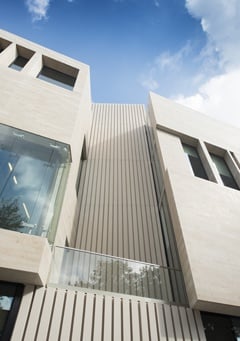Szerelmey's Jura stone project was short-listed for Stirling Prize
A new Jura limestone building in the UNESCO World Heritage Site at Maritime Greenwich was the stone industry's big hope in RIBA's top architectural award, the Stirling Prize, this year. But it lost out to a concrete modernist reimagining of 1950s/60s architect Sir Leslie Martin by AHMM. The winner was announced on 15 October.
The judges unanimously considered the new £40.9million concrete buildings at Burntwood School in Wandsworth the “clear winner”. Designed by architects Allford Hall Monaghan Morris (AHMM), they beat the other five shortlisted buildings, which included the new £38.9million University of Greenwich Jura stone-clad building in Stockwell Street, where the architects were Heneghan Peng, the main contractor Osborne and the stone specialist Szerelmey.
John Guest, Senior Contracts Manager at Szerelmey who headed the project for the specialist stone contractor, told NSS that the curved facade of the building meant every one of the nominally 75mm thick Jura cladding panels had its own individual profile on the front (the backs were flat for ease of fixing).
The stone was supplied to Szerelmey by Bavarian producers SSG-Geiger. Course heights were 135mm and although the lengths look random, there were a lot of careful calculations made to achieve the totally random effect the architects wanted while actually introducing some measure of standardisation for practical reasons.
The stone was fixed on to a Halfen stainless steel frame system using corbels and restraints, with insulation on to the concrete frame of the building. Every stone had to be produced to particularly fine tolerances to achieve the consistent joint thickness that this type of fixing demands.
There were five distinct elements to the cladding that were originally all going to be fixed at the same time, although in the end they were carried out as five separate parts of the project by the same team.
John Guest: "Because the programme ended up being spread over a longer period we had a relatively small team (eight people at the most) working on it, which is sometimes also the best way.
"Our guys are highly skilled and specialist at this type of complicated installation and pulled together brilliantly as a team. That's the secret of good stone projects: using a directly employed and trusted team, which we always do.
"Putting huge amounts of people on a job is not always the answer, as a small, professional team can often work more efficiently.
"Elements of the project such as Block 'E', where the wall projects upwards on the right hand side, was a bit of a fiddle to set out, but once the setting out was sorted the installation went extremely smoothly."
John admits he was unsure about the design of the building at first, but says: "The finished building looks fantastic! It definitely ranks as one of my favourite projects and I’m proud to have been involved with it.”

